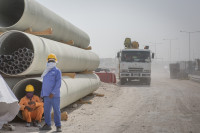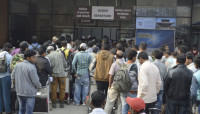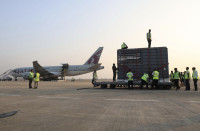Opinion
Building it right
It is time we considered geological factors like liquefaction while carrying out any construction activity
Rakam Lama Tamang
Several structural and foundation damages in buildings were observed in different locations during the recent Gorkha Earthquake. Some of these damages have been attributed to liquefaction. And given that the Kathmandu Valley is situated on a lakebed, the susceptibility of liquefaction is higher in the Capital.
During an earthquake, the pore water pressure in saturated soil increases as a result of seismic shaking. Increase in pore water pressure depends upon the magnitude of the earthquake, type of soil and drainage. In loose soil, an increase in pore water pressure may exceed the weight of soil, resulting in water completely surrounding the soil particle. As a result of this, soil behaves like a fluid, loosing significant bearing capacity, which is known as liquefaction. And since the fluid-like soil can no longer take the load, it can result in buildings tilting or settling down.
Kathmandu’s susceptibility
Kathmandu Valley’s deposition is lacustrine (related to lakes) and fluvial (found in river) in origin, consisting of silt, sand and clay in depths of up to 500m. During early stages of liquefaction study, sand was believed to be liquefiable; however, several studies carried out throughout the 1970s and 80s in different parts of the world have proved that sand containing fines also display evidence of liquefaction. So the soil type in Kathmandu is highly susceptible to liquefaction. This was proved during the 1934 earthquake and also by the recent earthquake. In fact, jets of water were said to have been seen in several locations during the 1934 quake.
Precautionary measures
There is a scarcity of engineers having proper knowledge of geotechnical earthquake-engineering. Basic equipment for studying dynamic soil properties through tests like cyclic triaxial test, resonant column test and cyclic shear test are not available in Nepal. For proper understanding of the dynamic soil behaviour, which helps to evaluate and study liquefaction, better lab and equipment should be provided for those pursuing courses in geotechnical earthquake-engineering. Without proper laboratory and site investigation, analysis and design of earthquake-resistant structure would be impossible.
Along with proper equipment and manpower, we also need to carry out detailed studies in liquefied areas and verify the existing liquefaction potential map. Revising the liquefaction-hazard map based on detailed geotechnical investigation and in-depth study of the current liquefied areas is important. This is crucial for future planning purpose and to construct better infrastructure. As globally accepted liquefaction evaluation criteria is not available in the case of silt, sand and clay, proper study of liquefied areas may contribute significantly in the liquefaction studies and help in the design of safe structures.
Construction work should be restricted in areas susceptible to liquefaction until a thorough geotechnical evaluation is carried out. Such investigation can help improve susceptible areas by using several ground-improvement techniques.
It is also important to issue proper guidelines for the construction of residential buildings in a way that they address both the geotechnical as well as structural factors in simple easily understandable language, so that even mid-level and junior-level technicians can easily monitor construction activities based on those instructions. The government should also prepare building codes taking liquefaction into account and implement them effectively.
It is also worth noting here that the structural design of the buildings up to three storeys earlier proposed by the Department of Urban Development and Building Construction does not deal with the construction of building on liquefiable soil, nor does it emphasise much on other geotechnical factors that need to be considered while constructing such houses. And while the international building code permits an increase of 33 percent bearing capacity when earthquake load is considered in the design, our building code recommends 50 percent increase in bearing capacity after considering earthquake load. This method of calculating bearing capacity may be only suitable for dense sand and stiff clay. It is not applicable for friable rocks and loose soil, which is susceptible to liquefaction.
Sloppy construction, weak buildings
Having said that, we must understand that liquefaction is just one of the major causes of structural damage. In the recent earthquakes, several buildings constructed on unliquefied soil and without any structural compromises exhibited excessive differential settlement and tilt. While it is true that buildings constructed on dense soil may also experience settlement and tilting due to the loss of soil’s bearing capacity, this sort of damage points towards our sloppy construction methods.
There is a trend in Nepal that once an architect or a civil engineer prepares the architectural drawing of any structure, it is assumed that the engineering part is completed. Worse still, a building smaller than three storeys does not require the approval of its structural drawing from the municipality. Such lax regulations and unscientific beliefs lead to the construction of buildings without proper supervision, which means that construction processes like detailing and reinforcement are based on local masons’ knowledge rather than that of a technically qualified person.
Such sloppy practices must end if we want our homes and infrastructure to be quake-resistant. Proper geotechnical evaluation before construction of any structure is necessary in order to prevent future destruction. We also should consider modifying and updating our current building code, since the code does not provide any definite liquefaction potential evaluation criteria.
Tamang works as a Civil/Geotechnical Engineer in the US




 6.12°C Kathmandu
6.12°C Kathmandu









%20(1).jpg&w=300&height=200)

